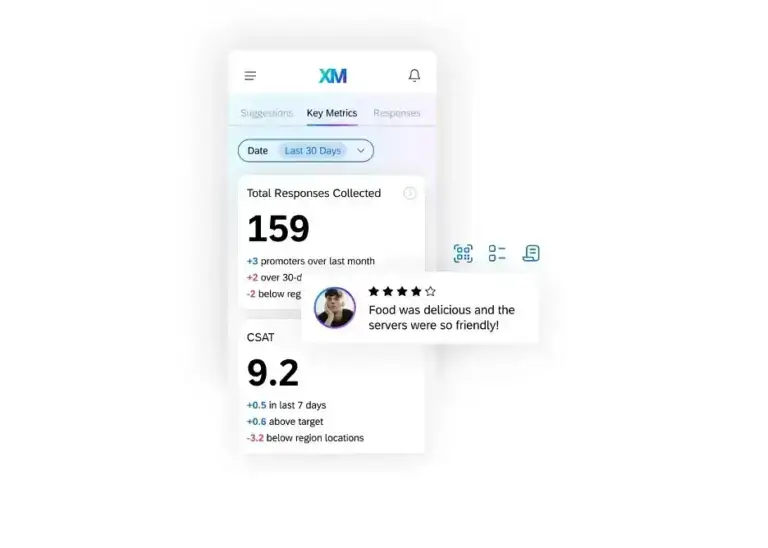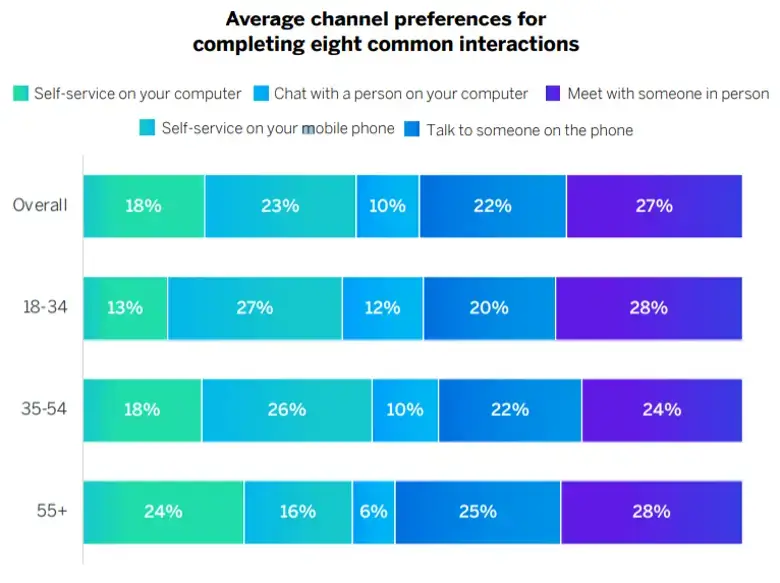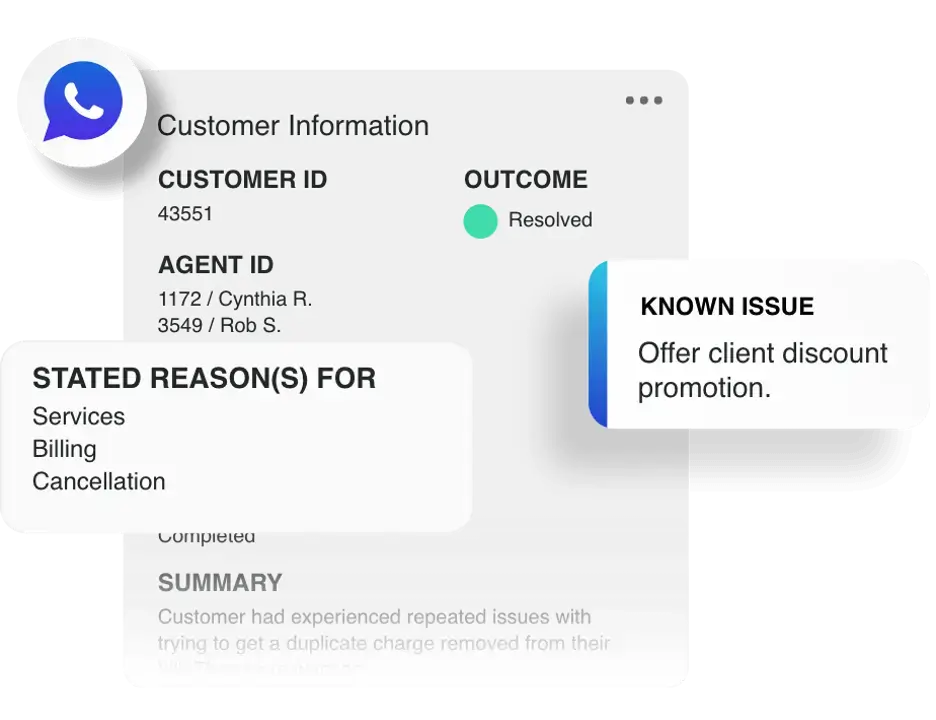What is phygital?
‘Phygital’ refers to the blend of customer experiences in the physical and digital worlds. For example, a phygital experience might begin in a physical store with the consideration of a purchase, before moving into the digital realm to finalize it or recommend it to others.
Ensuring your physical stores and digital assets are capable of providing a seamless experience from one to the other requires a marketing strategy and consumer strategy to match. Developing an omnichannel customer experience strategy is the best way to ensure that you don’t lose customers on their journey from the physical to the digital and vice versa.
Read on to discover how to augment your retail stores and digital experiences with the right technology, as well as the benefits of creating a phygital experience for your shoppers, customers and clients.
Free eBook: The digital experience playbook
Why is blending physical and digital worlds important for business?
There are several reasons why creating a phygital experience is important. Here are the main ones:
Physical locations aren’t the sum of customer experiences
Even when your business is location-based, the physical space won’t provide the total experience that customers will have with your brand. There are many brand touchpoints that happen outside of physical locations, such as on social media, review websites, emails, adverts and more. A true brand customer experience will be formed by a blend of the digital world and your physical store.
Customers want in-store experiences to extend into the digital world
Customers like consistency. A consistently great brand experience will bring customers back time and again – and creating an expectation of great service and a predictable interaction is formed through efforts in your physical stores and your online experiences.
When you create a phygital strategy, you’re able to provide brand experiences that transcend all platforms. An interaction with a sales associate in-store should feel the same as contacting a customer service representative online, with the tone and actions taken in line with your company’s brand style. A digital experience should reiterate to customers that your business is cohesive and consistent, whether they’re online shopping in virtual reality or returning an item in store.

Customers have varying preferences for contact, depending on need
There are several factors that can affect how a customer wants to interact with your brand. Demographics and the type of issue or transaction at hand can greatly change the way in which your customer wishes to interact.
For example, when completing eight common interactions, XM Institute research found that age played a great role in how customers wished to reach out for a solution:

Creating phygital experiences means that customers of all demographics can have the interactions they’re looking for on the platforms they prefer to use. This improves customer satisfaction and increases brand loyalty, as customers are able to have their expectations met.
Phygital experiences improve brand awareness and advantage
Having a physical store can capture local customers in a way digital channels may fail to reach – but digital outreach can help create brand awareness on a global scale. It ensures that your brand has one clear image and one consistent and immersive journey for consumers, wherever they interact with your brand.
Collectively, a phygital experience that flows effortlessly from the real world to the digital and vice versa can attract customers and retain them long after they’ve left a physical store or liked a social media post. This synchronized approach to customer experience can help to provide a competitive edge that puts your company above others.
Examples of phygital
Phygital strategy can take many forms, but here are a few examples of how the physical and digital aspects of a business could be combined.
An AR app in a physical store
Customers get a discount in store if they download a brand app with AR functionality. Geofenced ads served to nearby customers encourage them to take this action. Once customers download the app, they can generate an in-store code for a discount. The app can be used to provide more information on in-store items, with AR technology helping customers to find and “see” items in virtual use . Post-purchase, customers can be served with targeted marketing and survey requests via the app, as well as being offered further discounts to tempt them back to store.
Digital kiosks for online check in and ordering
Rather than requiring presentation in-person to check into a hotel, customers could use a digital kiosk that handles the check in process without the need for human intervention. The hotel could provide a digital guide to the area sent to the guest’s email, as well as prompting customers to feed back via surveys when they check out.
Digital kiosks can also be used to complete orders for fast food, ensuring that customers have accessed the menu, paid for items and been upsold all before reaching the POS.
Live video retail with in-store pickup
Instead of coming into a store to try on items, customers can go to social media to watch a live video try-on of clothing and buy directly through the app for in-store pickup. This allows customers to shop from their own homes but also brings in new customers to the brand fold as videos are disseminated through social media channels.
Customer service from home
Once a customer has purchased an item in store, should they require assistance with their product once home they can use the brand website to access digital help options, such as live chat function. They can return their items in store at their convenience, using returns information generated through a digital interaction with a customer service agent.
How to use the phygital world for business results
Understand the different roles of the digital world and the physical world
In-person experiences and digital interactions should complement each other – but though both facets of your business should work together, they will serve different purposes. Your channels (as mentioned) will have different roles to play in the customer actions being taken and the results your audience are seeking.
Empower your frontline teams to provide great experiences

Your frontline teams are an integral part of providing consumer experiences that resonate. Empowering them to give a consistent, brilliant experience to customers requires the support of tools and technological systems that deliver insights and prompts in a timely way, connecting your customer-facing employees to the collected knowledge of your customers’ past interactions, preferences and opinions. From digital team member to retail store manager, all frontline staff should be able to understand the shared vision of your brand and bring it to life.
Create a human connection
No matter where your customers find you, the experiences they have with your frontline teams become memorable and desirable because of the human connections you create. These leave lasting impressions that attract customers back and inspire recommendations to others.
Keeping track of your frontline teams’ ability to engage with customers and offering your team specific insights into customers will drive your experiences to the next level. With effective frontline management, you can ensure that every interaction exceeds expectations and strengthens the rapport between your customers and your brand.
Leverage new techniques and technologies
Blending physical and digital experiences using new techniques and technology can go a long way to improving customer interactions and opinions. For example, you could try:
- Connecting an in-store interaction to digital feedback on Google and Tripadvisor via strategically-placed QR codes
- Get location-specific feedback with embedded kiosk survey intercepts
- Using geofencing triggers to place adverts and mobile surveys in the hands of customers
What is the future of phygital?
With technology moving apace, the future of phygital will continue to evolve. As virtual reality, augmented reality and other technologies are made ever more sophisticated with tools such as artificial intelligence, the boundaries between the physical world and digital world will become increasingly blurred.
Phygital retail will become more sophisticated. Customers will be able to switch between digital spheres and physical ones for multifaceted experiences no matter where they are.
Make your phygital experiences seamless
Qualtrics® allows you to create seamless physical and digital experiences that delight customers time and again.
Get a holistic view of digital experiences and physical location feedback with combined experience data, with artificial intelligence-driven insights into behavioral cues. Understand the end-to-end customer journey and take action to reduce friction, optimize experiences and increase customer satisfaction and loyalty.
Free eBook: The digital experience playbook